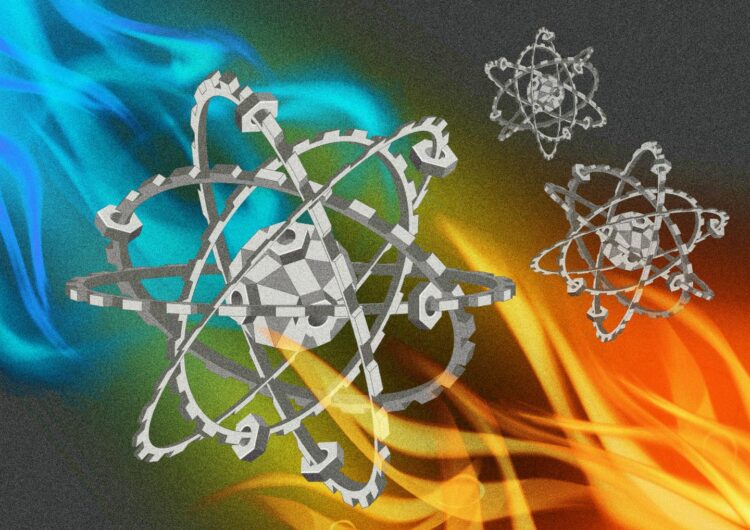Researchers in Singapore turn a single atom into a quantum engine and a quantum fridge

Credit: Aki Honda / Centre for Quantum Technologies, National University of Singapore
Here’s a new chapter in the story of the miniaturisation of machines: researchers in a laboratory in Singapore have shown that a single atom can function as either an engine or a fridge. Such a device could be engineered into future computers and fuel cells to control energy flows.
“Think about how your computer or laptop has a lot of things inside it that heat up. Today you cool that with a fan that blows air. In nanomachines or quantum computers, small devices that do cooling could be something useful,” says Dario Poletti from the Singapore University of Technology and Design (SUTD).
This work gives new insight into the mechanics of such devices. The work is a collaboration involving researchers at the Centre for Quantum Technologies (CQT) and Department of Physics at the National University of Singapore (NUS), SUTD and at the University of Augsburg in Germany. The results were published in the peer-reviewed journal npj Quantum Information on 1 May.
Engines and refrigerators are both machines described by thermodynamics, a branch of science that tells us how energy moves within a system and how we can extract useful work. A classical engine turns energy into useful work. A refrigerator does work to transfer heat, reducing the local temperature. They are, in some sense, opposites.
People have made small heat engines before using a single atom, a single molecule and defects in diamond. A key difference about this device is that it shows quantumness in its action. “We want to understand how we can build thermodynamic devices with just a few atoms. The physics is not well understood so our work is important to know what is possible,” says Manas Mukherjee, a Principal Investigator at CQT, NUS, who led the experimental work.
The researchers studied the thermodynamics of a single barium atom. They devised a scheme in which lasers move one of the atom’s electrons between two energy levels as part of a cycle, causing some energy to be pushed into the atom’s vibrations. Like a car engine consumes petrol to both move pistons and charge up its battery, the atom uses energy from lasers as fuel to increase its vibrating motion. The atom’s vibrations act like a battery, storing energy that can be extracted later. Rearrange the cycle and the atom acts like a fridge, removing energy from the vibrations.
In either mode of operation, quantum effects show up in correlations between the atom’s electronic states and vibrations. “At this scale, the energy transfer between the engine and the load is a bit fuzzy. It is no longer possible to simply do work on the load, you are bound to transfer some heat,” says Poletti. He worked out the theory with collaborators Jiangbin Gong at NUS Physics and Peter Hänggi in Augsburg. The fuzziness makes the process less efficient, but the experimentalists could still make it work.
Mukherjee and colleagues Noah Van Horne, Dahyun Yum and Tarun Dutta used a barium atom from which an electron (a negative charge) is removed. This makes the atom positively charged, so it can be more easily held still inside a metal chamber by electrical fields. All other air is removed from around it. The atom is then zapped with lasers to move it through a four-stage cycle.
The researchers measured the atom’s vibration after applying 2 to 15 cycles. They repeated a given number of cycles up to 150 times, measuring on average how much vibrational energy was present at the end. They could see the vibrational energy increasing when the atom was zapped with an engine cycle, and decreasing when the zaps followed the fridge cycle.
Understanding the atom-sized machine involved both complicated calculations and observations. The team needed to track two thermodynamic quantities known as ergotropy, which is the energy that can be converted to useful work, and entropy, which is related to disorder in the system. Both ergotropy and entropy increase as the atom-machine runs. There’s still a simple way of looking at it, says first author and PhD student Van Horne, “Loosely speaking, we’ve designed a little machine that creates entropy as it is filled up with free energy, much like kids when they are given too much sugar.”
###
Reference: Single-atom energy-conversion device with a quantum load, npj Quantum Information, DOI:10.1038/s41534-020-0264-6 (2020)
https:/
Media contacts:
Manas Mukherjee
Principal Investigator
Centre for Quantum Technologies, National University of Singapore
[email protected]
Dario Poletti
Associate Professor in Science, Technology and Mathematics Cluster and Engineering Product Development Pillar
Singapore University of Technology and Design
[email protected]
Noah Van Horne
PhD Student
Centre for Quantum Technologies, National University of Singapore
[email protected]
Acknowledgments
The authors acknowledge support by Singapore MOE Academic Research Fund Tier-2 (project nos. MOE2014-T2-2-119 and MOE2016-T2-2-120) and by the National Research Foundation Singapore under its Competitive Research Programme (CRP Award no. NRF-CRP14-2014-02).
Media Contact
Jenny Hogan
[email protected]
Related Journal Article
http://dx.





